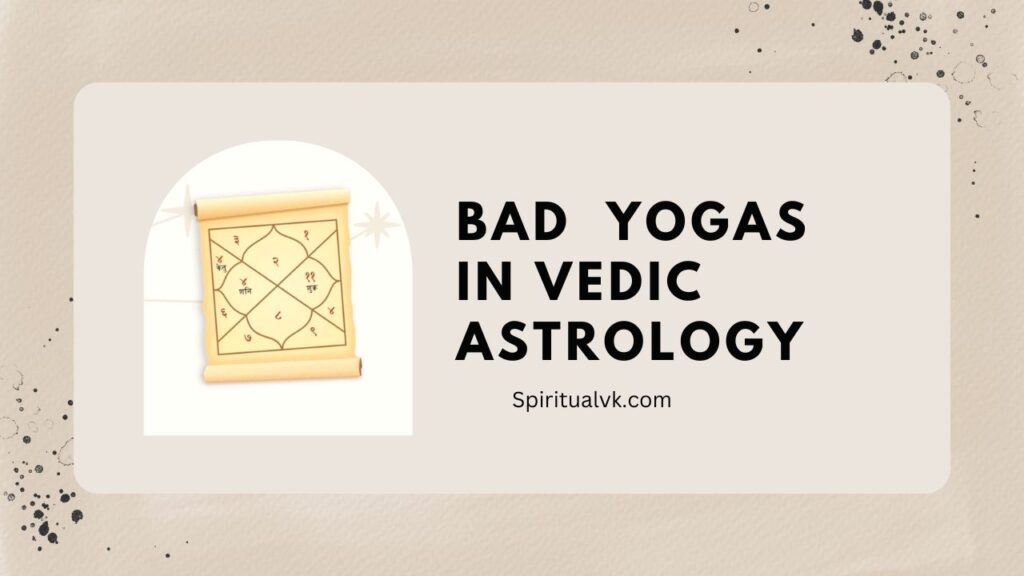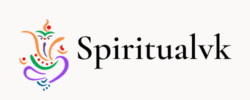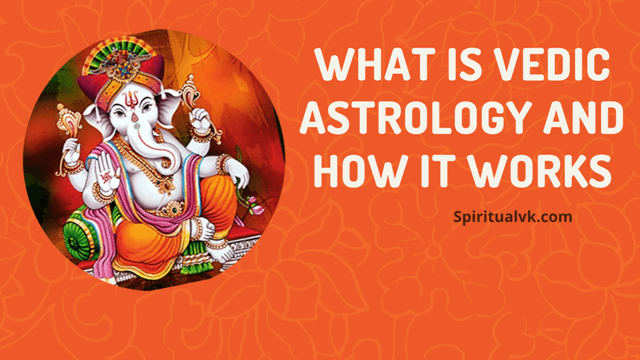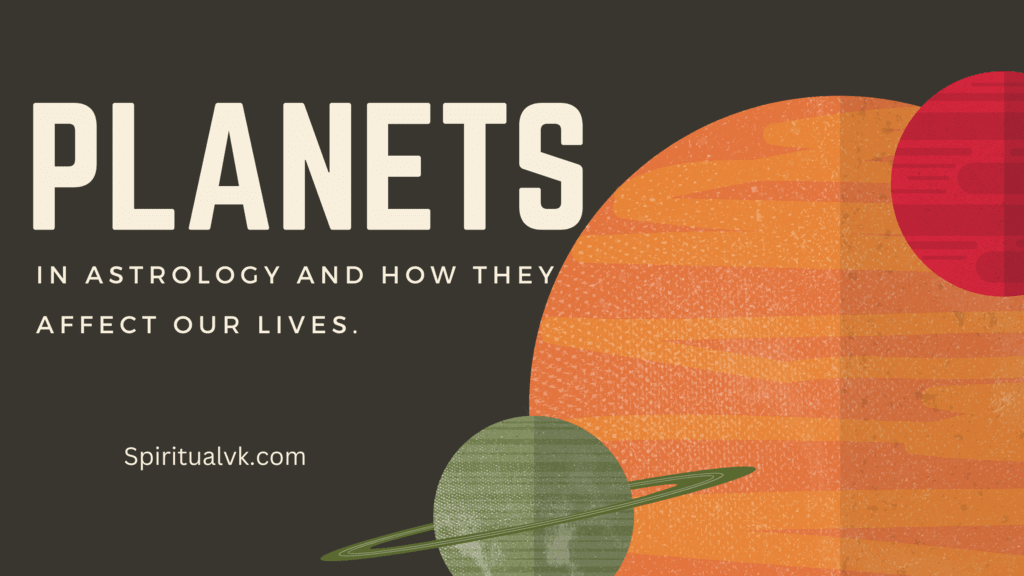Vedic astrology, also known as Jyotish, is a complex system of predicting the future and understanding the past and present through the positions of celestial bodies. One of the fundamental concepts in Vedic astrology is the formation of “Yogas,” which are specific combinations of planets in a birth chart that can have a significant impact on an individual’s life. While there are many auspicious Yogas that bring prosperity, success, and happiness, there are also “Bad Yogas” or “Doshas” that can bring challenges, obstacles, and hardships. Understanding these Bad Yogas in Vedic astrology is crucial for anyone seeking to comprehend the full picture of their astrological chart.

1. What are Bad Yogas?
In Vedic astrology, a “Yoga” is a specific combination or relationship between planets, houses, and signs that influences a person’s life. “Bad Yogas” or “Doshas” refer to those combinations that create negative influences or challenges in a person’s life. These can manifest in various forms, such as financial difficulties, health problems, relationship issues, or obstacles in career and personal growth.
Bad Yogas are not necessarily indicative of a doomed life. Instead, they highlight areas where an individual may face challenges, which, with awareness and appropriate remedies, can be mitigated or transformed. The concept of Yogas, both good and bad, underscores the belief that life is a mixture of favorable and unfavorable circumstances, and astrology provides insights into navigating these complexities.
2. Types of Bad Yogas
There are numerous Bad Yogas in Vedic astrology, each with its unique implications. Some of the most commonly discussed ones include:
a) Kalasarpa Yoga
Kalasarpa Yoga occurs when all the planets are hemmed between Rahu (the North Node of the Moon) and Ketu (the South Node of the Moon). This Yoga is believed to bring significant challenges, including delays in success, mental stress, and obstacles in various aspects of life. The person may feel trapped in certain situations and find it difficult to achieve their goals. However, it’s important to note that the effects of Kalasarpa Yoga can vary depending on the overall strength of the chart and other mitigating factors.
b) Shani Dosha (Saturn’s Affliction)
Shani Dosha arises when Saturn is placed in a weak or malefic position in the birth chart. This can lead to various issues, such as financial struggles, health problems, and delays in achieving success. Saturn is a planet of discipline, hard work, and karmic retribution, so its negative influence can make life feel like an uphill battle. However, Saturn’s lessons are often about perseverance, patience, and endurance, and individuals with Shani Dosha can overcome its effects through consistent effort and discipline.
c) Manglik Dosha (Mangal Dosha)
Manglik Dosha occurs when Mars is placed in the 1st, 4th, 7th, 8th, or 12th house of a person’s birth chart. This Dosha is particularly feared when it comes to marriage, as it is believed to cause conflicts, delays, and disharmony in marital life. The intensity of Manglik Dosha can vary, and it can be mitigated or canceled through various astrological remedies, including marrying another Manglik individual or performing specific rituals.
d) Nadi Dosha
Nadi Dosha is considered a significant impediment in Vedic astrology, particularly in the context of marriage compatibility. It occurs when the Nadi, one of the eight factors considered in the Ashtakoot system of matching horoscopes, is the same for both partners. This Dosha is believed to lead to various marital problems, including health issues for the couple, difficulties in conception, or even the possibility of separation. However, like other Doshas, Nadi Dosha can be addressed through remedies and other balancing factors in the horoscope.
e) Pitru Dosha
Pitru Dosha arises due to the malefic positioning of the Sun and the influence of Rahu or Saturn in the 9th house of a person’s horoscope, which is the house of the father, ancestors, and Dharma. This Dosha is believed to result from the unresolved karmas of one’s ancestors and can lead to various challenges, such as health issues, financial instability, and difficulties in family life. Pitru Dosha is often associated with the need to perform rituals and charitable acts to appease the ancestors and mitigate the Dosha’s effects.
3. Understanding the Impact of Bad Yogas
The impact of Bad Yogas on a person’s life can be profound, but it is important to approach these Yogas with a balanced perspective. Not every Bad Yoga will have an equally severe effect on every individual, and the overall strength of the birth chart, the presence of beneficial Yogas, and the timing of planetary periods (Dashas) all play a significant role in determining the outcome.
For example, Kalasarpa Yoga might cause significant obstacles for one person, while another individual with the same Yoga might experience only minor delays. The difference lies in the overall configuration of the chart, the strength of the ascendant (Lagna), and the aspects of other planets. Moreover, the presence of strong benefic planets like Jupiter or Venus can mitigate the effects of a Bad Yoga, providing protection and relief.
4. Remedies for Bad Yogas
Vedic astrology offers various remedies to mitigate the effects of Bad Yogas. These remedies are based on the principle that the negative influences of planets can be reduced or transformed through specific actions, rituals, and spiritual practices. Some of the common remedies include:
a) Mantras
Reciting specific mantras related to the afflicted planet or deity associated with the Yoga can help mitigate its effects. For example, chanting the “Mahamrityunjaya Mantra” is believed to alleviate the malefic effects of Saturn.
b) Gemstones
Wearing gemstones associated with benefic planets can strengthen those planets and protect against the negative effects of Bad Yogas. For example, wearing a blue sapphire for Saturn can help reduce the impact of Shani Dosha. However, you need to consult an astrologer before wearing a gemstone.
c) Charitable Acts
Performing charitable acts, particularly those related to the afflicted planet, is another effective remedy. For instance, donating to causes associated with Saturn, such as helping the elderly or the poor, can alleviate the effects of Shani Dosha.
d) Rituals and Pujas
Specific rituals and Pujas, such as the Navagraha Puja or the Kalsarpa Shanti Puja, can be performed to appease the planets and reduce the impact of Bad Yogas. These rituals are often conducted by experienced priests and can be tailored to the individual’s specific astrological needs.
e) Fasting
Observing fasts on specific days associated with the afflicted planet is another common remedy. For example, fasting on Saturdays can help mitigate the effects of Shani Dosha.
5. Conclusion: Embracing the Journey with Awareness
Bad Yogas in Vedic astrology serve as indicators of potential challenges in life. However, they are not deterministic forces that doom an individual to a life of suffering. Instead, they offer insights into areas where one may need to exercise greater caution, patience, and effort. The remedies provided by Vedic astrology offer practical ways to navigate these challenges and transform them into opportunities for growth and self-improvement.
It’s important to approach the concept of Bad Yogas with a balanced perspective. While they indicate potential difficulties, they also highlight the areas where personal growth is most likely to occur. In many cases, the challenges posed by Bad Yogas can lead to significant spiritual and personal development, as they push individuals to overcome obstacles and develop resilience.
Ultimately, Vedic astrology, including the study of Bad Yogas, is a tool for self-awareness and understanding. By recognizing the influences of these Yogas and taking proactive steps to address them, individuals can navigate their life’s journey with greater wisdom, compassion, and clarity.


